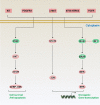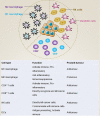Molecular characteristics and immune microenvironment of gastrointestinal stromal tumours: targets for therapeutic strategies
- PMID: 39070147
- PMCID: PMC11272528
- DOI: 10.3389/fonc.2024.1405727
Molecular characteristics and immune microenvironment of gastrointestinal stromal tumours: targets for therapeutic strategies
Abstract
Gastrointestinal stromal tumours (GISTs) are the most common mesenchymal tumours, arising mainly from the interstitial cells of Cajal (ICCs) of the gastrointestinal tract. As radiotherapy and chemotherapy are generally ineffective for GISTs, the current primary treatment is surgical resection. However, surgical resection is not choice for most patients. Therefore, new therapeutic strategies are urgently needed. Targeted therapy, represented by tyrosine kinase inhibitors (TKIs), and immunotherapy, represented by immune checkpoint inhibitor therapies and chimeric antigen receptor T-cell immunotherapy (CAR-T), offer new therapeutic options in GISTs and have shown promising treatment responses. In this review, we summarize the molecular classification and immune microenvironment of GISTs and discuss the corresponding targeted therapy and immunotherapy options. This updated knowledge may provide more options for future therapeutic strategies and applications in GISTs.
Keywords: gastrointestinal stromal tumours; immune microenvironment; immunotherapy; molecular characteristics; targeted therapy.
Copyright © 2024 Yu, Yu, Luo, Zhang, Zeng, Chen, Lin, Chen and Wang.
Conflict of interest statement
Author MY was employed by the company Guangzhou KingMed Diagnostics Group Co., Ltd. The remaining authors declare that the research was conducted in the absence of any commercial or financial relationships that could be construed as a potential conflict of interest.
Figures






Similar articles
-
Current research and treatment for gastrointestinal stromal tumors.World J Gastroenterol. 2017 Jul 21;23(27):4856-4866. doi: 10.3748/wjg.v23.i27.4856. World J Gastroenterol. 2017. PMID: 28785140 Free PMC article. Review.
-
[Immunotherapy of Gastrointestinal Stromal Tumors].Zhongguo Yi Xue Ke Xue Yuan Xue Bao. 2019 Oct 30;41(5):696-701. doi: 10.3881/j.issn.1000-503X.11097. Zhongguo Yi Xue Ke Xue Yuan Xue Bao. 2019. PMID: 31699203 Review. Chinese.
-
Recent advances in the management of gastrointestinal stromal tumor.World J Clin Cases. 2020 Aug 6;8(15):3142-3155. doi: 10.12998/wjcc.v8.i15.3142. World J Clin Cases. 2020. PMID: 32874969 Free PMC article. Review.
-
Advances in immunology and immunotherapy for mesenchymal gastrointestinal cancers.Mol Cancer. 2023 Apr 18;22(1):71. doi: 10.1186/s12943-023-01770-6. Mol Cancer. 2023. PMID: 37072770 Free PMC article. Review.
-
Imatinib mesylate: in the treatment of gastrointestinal stromal tumours.Drugs. 2003;63(5):513-22; discussion 523-4. doi: 10.2165/00003495-200363050-00005. Drugs. 2003. PMID: 12600228 Review.
References
Publication types
LinkOut - more resources
Full Text Sources
Research Materials

